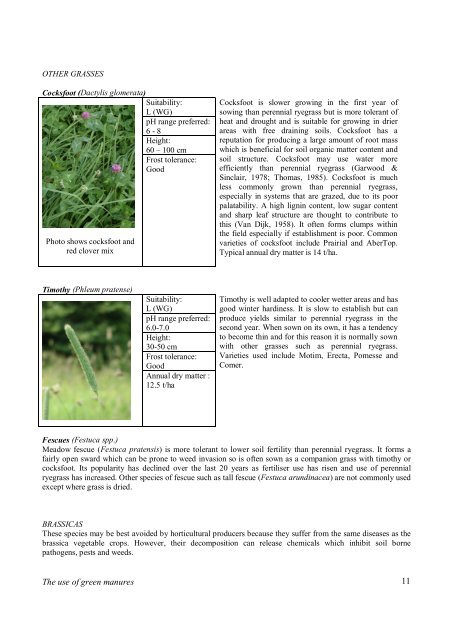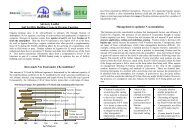Green Manures booklet - Institute of Organic Training and Advice
Green Manures booklet - Institute of Organic Training and Advice
Green Manures booklet - Institute of Organic Training and Advice
Create successful ePaper yourself
Turn your PDF publications into a flip-book with our unique Google optimized e-Paper software.
OTHER GRASSES<br />
Cocksfoot (Dactylis glomerata)<br />
Suitability:<br />
L (WG)<br />
pH range preferred:<br />
6 - 8<br />
Height:<br />
Photo shows cocksfoot <strong>and</strong><br />
red clover mix<br />
Timothy (Phleum pratense)<br />
The use <strong>of</strong> green manures<br />
60 – 100 cm<br />
Frost tolerance:<br />
Good<br />
Suitability:<br />
L (WG)<br />
pH range preferred:<br />
6.0-7.0<br />
Height:<br />
30-50 cm<br />
Frost tolerance:<br />
Good<br />
Annual dry matter :<br />
12.5 t/ha<br />
Cocksfoot is slower growing in the first year <strong>of</strong><br />
sowing than perennial ryegrass but is more tolerant <strong>of</strong><br />
heat <strong>and</strong> drought <strong>and</strong> is suitable for growing in drier<br />
areas with free draining soils. Cocksfoot has a<br />
reputation for producing a large amount <strong>of</strong> root mass<br />
which is beneficial for soil organic matter content <strong>and</strong><br />
soil structure. Cocksfoot may use water more<br />
efficiently than perennial ryegrass (Garwood &<br />
Sinclair, 1978; Thomas, 1985). Cocksfoot is much<br />
less commonly grown than perennial ryegrass,<br />
especially in systems that are grazed, due to its poor<br />
palatability. A high lignin content, low sugar content<br />
<strong>and</strong> sharp leaf structure are thought to contribute to<br />
this (Van Dijk, 1958). It <strong>of</strong>ten forms clumps within<br />
the field especially if establishment is poor. Common<br />
varieties <strong>of</strong> cocksfoot include Prairial <strong>and</strong> AberTop.<br />
Typical annual dry matter is 14 t/ha.<br />
Timothy is well adapted to cooler wetter areas <strong>and</strong> has<br />
good winter hardiness. It is slow to establish but can<br />
produce yields similar to perennial ryegrass in the<br />
second year. When sown on its own, it has a tendency<br />
to become thin <strong>and</strong> for this reason it is normally sown<br />
with other grasses such as perennial ryegrass.<br />
Varieties used include Motim, Erecta, Pomesse <strong>and</strong><br />
Comer.<br />
Fescues (Festuca spp.)<br />
Meadow fescue (Festuca pratensis) is more tolerant to lower soil fertility than perennial ryegrass. It forms a<br />
fairly open sward which can be prone to weed invasion so is <strong>of</strong>ten sown as a companion grass with timothy or<br />
cocksfoot. Its popularity has declined over the last 20 years as fertiliser use has risen <strong>and</strong> use <strong>of</strong> perennial<br />
ryegrass has increased. Other species <strong>of</strong> fescue such as tall fescue (Festuca arundinacea) are not commonly used<br />
except where grass is dried.<br />
BRASSICAS<br />
These species may be best avoided by horticultural producers because they suffer from the same diseases as the<br />
brassica vegetable crops. However, their decomposition can release chemicals which inhibit soil borne<br />
pathogens, pests <strong>and</strong> weeds.<br />
11




